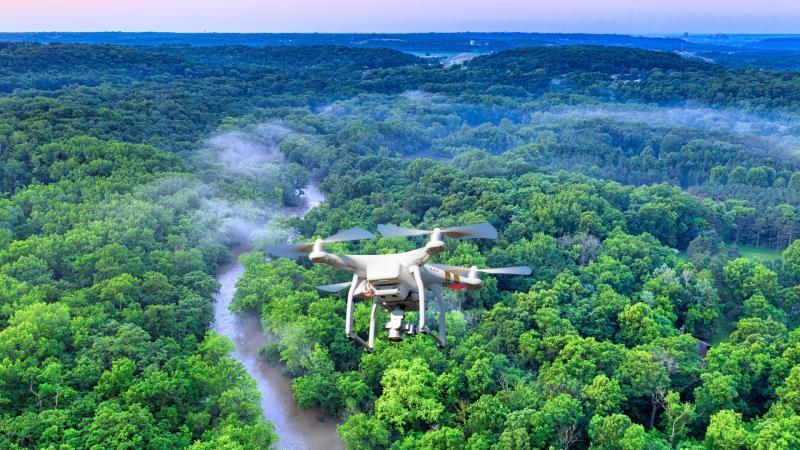
Chennai Researchers Develop Aerial Eye Tree Detection Algorithm
In a groundbreaking development, researchers at VIT Chennai have successfully created the Aerial Eye Tree Detection Algorithm (AETDA), a innovative system that leverages high-resolution drone imagery and the YOLOv8 deep learning model to automatically count and classify individual tree crowns. This pioneering technology has the potential to revolutionize the field of forestry and environmental conservation by providing a fast, accurate, and scalable alternative to traditional manual surveys.
The AETDA system utilizes drones equipped with high-resolution cameras to capture detailed images of tree crowns, which are then processed using the YOLOv8 deep learning model. This model is a state-of-the-art object detection algorithm that has been trained on a vast dataset of images to recognize and classify specific objects, in this case, tree crowns. The algorithm is capable of detecting and classifying three types of tree crowns: banana, oil palm, and coconut.
The researchers have reported an overall accuracy of 0.722 (mAP50) for the AETDA system, which is a significant improvement over traditional manual survey methods. The high accuracy of the system can be attributed to the high-resolution drone imagery and the advanced object detection capabilities of the YOLOv8 model. The system’s ability to automatically count and classify tree crowns also reduces the time and effort required for manual surveys, making it a more efficient and cost-effective solution.
The AETDA system has far-reaching implications for the field of forestry and environmental conservation. Accurate tree counting and classification are essential for monitoring forest health, tracking changes in tree populations, and identifying areas that require conservation efforts. The system can also be used to monitor the spread of diseases, track the impact of climate change, and identify areas that are vulnerable to deforestation.
One of the significant advantages of the AETDA system is its scalability. The system can be easily deployed in large areas, making it an ideal solution for monitoring vast forest regions. The use of drones and deep learning models also reduces the need for manual labor, making it a more efficient and cost-effective solution.
The development of the AETDA system is a testament to the power of interdisciplinary research and collaboration. The researchers at VIT Chennai have demonstrated the potential of combining cutting-edge technologies like drones and deep learning models to solve real-world problems. The system has the potential to be adapted for use in other fields, such as agriculture, urban planning, and disaster response.
In conclusion, the Aerial Eye Tree Detection Algorithm developed by researchers at VIT Chennai is a groundbreaking innovation that has the potential to revolutionize the field of forestry and environmental conservation. The system’s high accuracy, scalability, and efficiency make it an ideal solution for monitoring forest health and tracking changes in tree populations. As the world grapples with the challenges of climate change, deforestation, and environmental degradation, the AETDA system offers a promising solution for conservation efforts.
The use of drones and deep learning models in the AETDA system is a significant step forward in the development of innovative technologies for environmental conservation. The system’s ability to automatically count and classify tree crowns reduces the need for manual labor, making it a more efficient and cost-effective solution. The high-resolution drone imagery and advanced object detection capabilities of the YOLOv8 model also provide a high level of accuracy, making the system a reliable tool for monitoring forest health.
As the world continues to urbanize and the demand for natural resources increases, the need for accurate and efficient monitoring of forest health becomes more pressing. The AETDA system offers a promising solution for conservation efforts, and its development is a testament to the power of interdisciplinary research and collaboration. The system has the potential to be adapted for use in other fields, and its impact is likely to be felt across various industries and sectors.
The AETDA system is a significant development in the field of forestry and environmental conservation, and its potential impact is substantial. The system’s ability to automatically count and classify tree crowns, monitor forest health, and track changes in tree populations makes it an essential tool for conservation efforts. The use of drones and deep learning models in the system is a significant step forward in the development of innovative technologies for environmental conservation, and its impact is likely to be felt for years to come.
In the future, the AETDA system is likely to play a critical role in monitoring forest health and tracking changes in tree populations. The system’s high accuracy, scalability, and efficiency make it an ideal solution for conservation efforts, and its potential impact is substantial. As the world continues to grapple with the challenges of climate change, deforestation, and environmental degradation, the AETDA system offers a promising solution for conservation efforts.
For more information on this groundbreaking development, please visit:
https://researchmatters.in/news/drones-and-deep-learning-join-forces-map-and-count-trees-accurately




